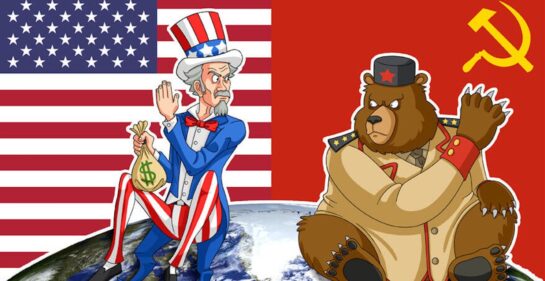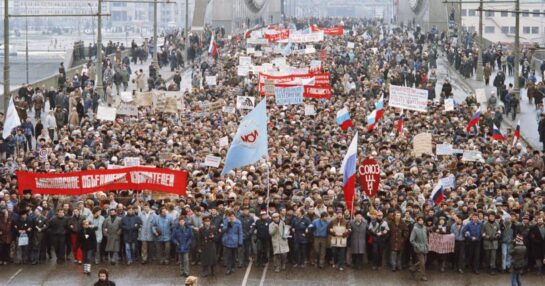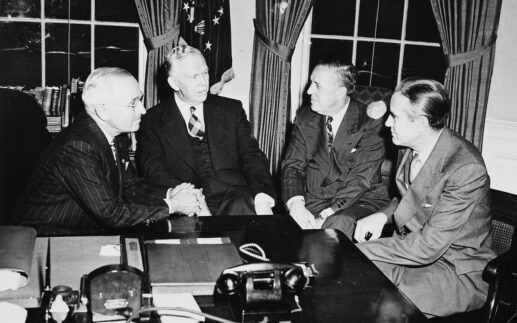Title: The Cold War: A Clash of Ideologies That Defined a Generation
The Cold War, spanning from the late 1940s to the early 1990s, was a period of intense geopolitical tension between the United States and its Western allies and the Soviet Union and its Eastern Bloc allies. Characterized by ideological rivalry, military build-up, and proxy conflicts, the Cold War shaped the world order and left a lasting impact on global politics.

Origins of the Cold War:
The roots of the Cold War can be traced back to the aftermath of World War II. While the United States and the Soviet Union had been allies in the fight against Nazi Germany, their relationship quickly soured due to fundamental ideological differences. The U.S. promoted capitalism and democracy, while the Soviet Union advocated for communism and authoritarianism.
The Truman Doctrine and Containment:
The beginning of the Cold War is often marked by the announcement of the Truman Doctrine in 1947. In response to Soviet expansionism in Eastern Europe, President Harry Truman pledged to contain communism and provide economic and military aid to countries threatened by Soviet influence. This policy of containment became the cornerstone of U.S. foreign policy throughout the Cold War.
The Marshall Plan and the Division of Europe:
To rebuild war-torn Europe and prevent the spread of communism, the United States implemented the Marshall Plan in 1948, providing billions of dollars in economic assistance to Western European countries. In response, the Soviet Union established the Eastern Bloc and imposed communist governments in Eastern Europe. The division of Europe into East and West set the stage for decades of confrontation and competition.
Nuclear Arms Race and Détente:
The Cold War was characterized by a nuclear arms race between the United States and the Soviet Union, leading to the development of increasingly powerful and destructive weapons. Both sides amassed huge arsenals of nuclear weapons, leading to the doctrine of mutually assured destruction (MAD), which deterred direct military conflict.
Despite the tension, there were periods of détente, or relaxation of tensions, during the Cold War. This was marked by diplomatic efforts to reduce the risk of nuclear war, such as the Strategic Arms Limitation Talks (SALT) and the Helsinki Accords, which aimed to promote human rights and cooperation between East and West.
Proxy Conflicts and the Spread of Communism:
While direct military confrontation between the United States and the Soviet Union was avoided, the Cold War was characterized by numerous proxy conflicts in regions such as Korea, Vietnam, and Latin America. These conflicts saw the U.S. and Soviet Union supporting opposing sides, often with devastating consequences for the countries involved.
Collapse of the Soviet Union and End of the Cold War:

The Cold War came to an abrupt end in the late 1980s and early 1990s with the collapse of the Soviet Union and the Eastern Bloc. Economic stagnation, internal dissent, and the reforms of Soviet leader Mikhail Gorbachev, such as glasnost (openness) and perestroika (restructuring), contributed to the dissolution of communist regimes across Eastern Europe.
In 1991, the Soviet Union officially dissolved, marking the end of the Cold War era. The United States emerged as the sole superpower, but the post-Cold War world brought new challenges, including the proliferation of weapons of mass destruction, ethnic conflicts, and the rise of non-state actors.
Legacy of the Cold War:
The Cold War left a profound legacy on global politics, shaping alliances, ideologies, and international relations for decades to come. It divided the world into competing blocs, influenced domestic policies and public discourse, and left a lasting impact on the psyche of generations who lived through it.
While the Cold War formally ended, its echoes can still be felt in contemporary geopolitics, as tensions between the United States and Russia persist, and the specter of nuclear conflict remains a concern. Understanding the complexities of the Cold War era is essential for grasping the dynamics of the modern world and navigating the challenges of the 21st century.
Referance:Chatgpt

